|
|

MAIN DISABLING CONDITION
People may have a variety of health conditions or diseases during their lives. For some people, a long-term physical or mental health condition culminates in a disability, which makes it difficult for them to carry out certain activities. Some conditions, such as arthritis, may not result in disability in the short-term but does so after the effects of the disease increase along with the ageing process. The number of people with this type of condition can be a useful indicator of the number of people who may potentially develop a disabling condition. Other conditions such as asthma are less restrictive to people's lifestyles and are therefore less likely to cause a disability.
People with disabilities often suffer from more than one long-term condition at one time, any number of which may contribute to restrictions in being able to do everyday tasks. For example, a respondent may report cataracts, deafness, arthritis and back pain. The respondent is asked to identify which of these conditions gives them the most trouble when carrying out every day activities. This condition then becomes their 'main disabling condition'.
HEALTH CONDITIONS BY STATE AND TERRITORY AND AGE GROUPS
The data analysis below examines the specific conditions in which there were statistically significant decreases in prevalence. It also examines which of the main disabling conditions contributed to the disparity between the 2003 and 2009 state and territory data.
Diseases of the musculoskeletal system and connective tissue
Musculoskeletal conditions are defined as diseases of the bones, muscles and their attachments, including joint problems, such as arthritis. Although there are more than one hundred musculoskeletal conditions, the most common are osteoarthritis, rheumatoid arthritis, osteoporosis and back pain.
Diseases of the musculoskeletal system and connective tissue were identified as the most prevalent group of main disabling conditions in Australia in both 2003 and 2009 (Graph 6). However, the overall rate decreased significantly from 6.8% in 2003, to 6.5% in 2009. The largest falls were in the 18-44 year age group (down 0.8%) and the 45-64 year age group (down 1.6%). |
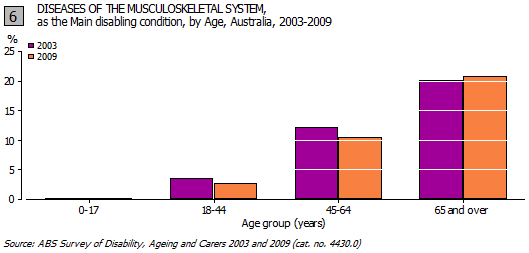
| Queensland and Tasmania experienced the largest decreases in the prevalence of musculoskeletal conditions as the main disabling condition in 2009. Queensland's rate fell from 7.6% in 2003 to 6.0% in 2009 and Tasmania from 9.2% to 8.2%. New South Wales was the only state that recorded an increase, from 6.0% to 6.4% (Graph 7). |
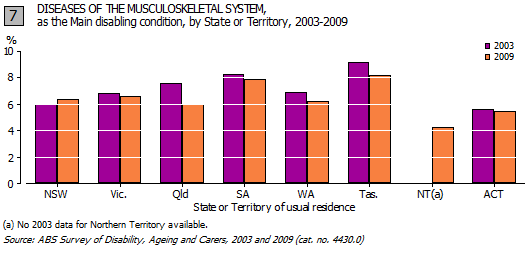 Arthritis
Arthritis
| Of people reporting arthritis as the main disabling condition, there was a significant reduction in the 45-64 year age group from 4.7% in 2003, to 4.0% in 2009 (Graph 8). Several factors may affect these results, including new and more effective treatments and the withdrawal from the market of arthritis medication that had a high rate of side effects.1 |
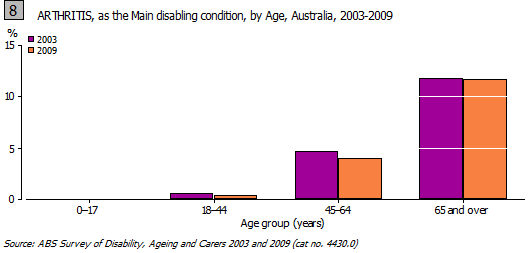
There were variations across State/Territory in the decrease of arthritis between 2003 and 2009 (Graph 9). The greatest decrease in arthritis as the main disabling condition was experienced in Queensland (3.2% in 2003 to 2.3% in 2009). New South Wales, South Australia, Western Australia and Tasmania remained about the same, with slight increases in Victoria and the Australian Capital Territory.

Back problems
Chronic back pain is another of the main disabling conditions and can be attributed to numerous causes including muscle strain or the displacement of intervertebral discs.
Overall, the prevalence of back pain as the main disabling condition has decreased in Australia, from 3.1% in 2003 to 2.9% in 2009 (Graph 10).
The decrease was statistically significant in the 18-44 year age group, from 2.6% in 2003 to 1.9% in 2009 and the 45-64 year age group from 6.0% to 5.2%. The reverse was reported for the 65 years and over population, with an increase from 4.9% in 2003 to 6.3% in 2009.

All states and territories reported a decrease in the incidence of back problems as the main cause of disability, with the exception of New South Wales which increased from 2.7% in 2003 to 3.1% in 2009 (Graph 11).
 |
Diseases of the circulatory system
Circulatory diseases are a broad group of conditions relating to the heart and vascular system, ranging from heart attack, to angina, stroke, varicose veins and high blood pressure.
Deaths due to heart, stroke and vascular disease have declined over the last three decades, largely due to better prevention, treatment and a greater awareness of risks. Despite this decline, heart, stroke and vascular disease is still one of Australia's biggest killers and one of the largest contributors to the burden of disease.
In 2003, 1.8% of the Australian population reported diseases of the circulatory system as being their main disabling condition, compared to 1.4% in 2009 (Graph 12).
Queensland had the greatest reduction in reporting of circulatory diseases as the main disabling condition, from 1.7% in 2003 to 1.2% in 2009. The New South Wales and South Australian prevalence rates both decreased from 2.0% to 1.6%. Victorian rates decreased from 1.8% to 1.5% and the other states decreased marginally, apart from the Australian Capital Territory where an increase was experienced, from 0.7% to 0.9%.
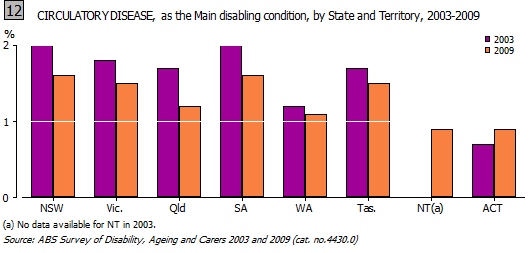 |
Heart disease
| There was a statistically significant reduction in reporting of heart disease as the main disabling condition in 45-64 year olds from 1.1% in 2003 to 0.6% in 2009, and in the 65 years and over age group from 3.8% to 3.4% (Graph 13). |
 Stroke
Stroke
| The prevalence of stroke as the main disabling condition also decreased overall, from 0.4% in 2003 to 0.3% in 2009. Although the incidence of stroke in 45-64 year olds increased from 0.2% in 2003 to 0.3% in 2009, this was offset by a decrease in the 65 years and over age group, from 2.1% to 1.3% (Graph 14). |
 Hypertension
Hypertension
Unlike heart disease and stroke, prevalence rates of hypertension as the main disabling condition remained similar between 2003 and 2009, at 0.4% in 2003 and 2009 (Graph 15).

Diseases of the respiratory system
Diseases of the respiratory system include asthma, emphysema, bronchitis, chronic airways obstruction and other respiratory disease most often characterised by shortness of breath and restriction in oxygen intake.
In 2003, 1.2% of people in Australia reported a disease of the respiratory system as being their main disabling condition, compared to 0.9% in 2009. The main contributor to the decrease in diseases of the respiratory system between 2003 and 2009 was asthma.
Asthma as the main disabling condition decreased amongst persons aged 0-17 years from 0.9% in 2003 to 0.5% in 2009 and also in the 18-44 year age group, from 0.5% to 0.3% (Graph 16).

Every state, except for New South Wales, experienced a decrease in the reporting of asthma as a cause of disability. Rates fell by 0.5% in South Australia; 0.4% in Victoria, Western Australia, Tasmania; 0.3% in Queensland and 0.2% in the Australian Capital Territory. New South Wales rates remained at 0.6% for both 2003 and 2009 (Graph 17).
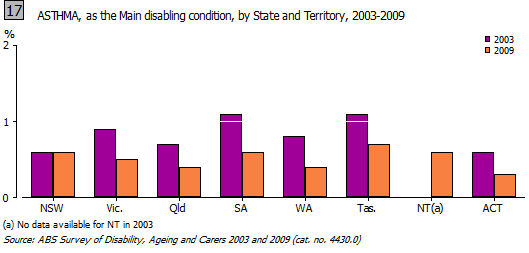
Endocrine, nutritional and metabolic disorders (diabetes and thyroid)
Diabetes can result in many long-term health conditions, including heart disease, stroke, kidney failure, blindness and lower limb amputation. It is a chronic condition in which blood glucose levels become too high due to the body producing little or no insulin, or not using insulin properly. Chronic diseases such as diabetes represent a major part of the burden of disease in Australia, and may be prevented or delayed by lifestyle interventions.
Although the total prevalence rate of endocrine, nutritional and metabolic disorders remained the same between 2003 and 2009, variation occurred between the states (Graph 18). Reporting of this condition as the main cause of disability increased in Victoria, Queensland and Tasmania. It remained the same in New South Wales and the Australian Capital Territory, and decreased in South Australia and Western Australia.
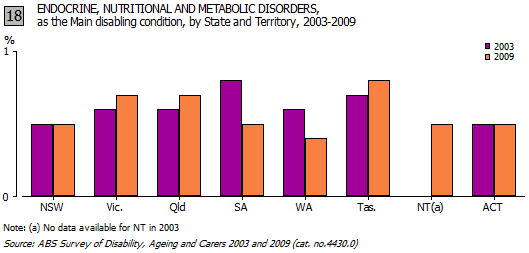
The prevalence rate of diabetes as the main disabling condition remained the same between 2003 and 2009, at 0.4%. Although there was a minimal decrease in the 45-64 year age group from 0.6% to 0.5%, this was offset by a small increase in the 65 years and over age group from 1.8% to 1.9% (Graph 19). |
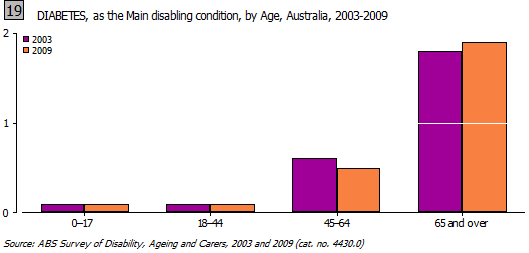 Mental and behavioural disorders
Mental and behavioural disorders
Mental health problems and mental illness are among the greatest causes of disability, diminished quality of life, and reduced productivity. People affected by mental health problems often have high levels of morbidity and mortality, experiencing poorer general health and higher rates of death from a range of causes, including suicide 6.
Mental and behavioural disorders include psychoses and mood affective disorders, dementia and Alzheimer's, depression, nervous tension and stress.
The prevalence of mental and behavioural disorders being reported as the main disabling condition decreased marginally between 2003 (3.2%) and 2009 (3.1%). The main change is attributable to a decrease in reporting in the 65 years and over age group, from 4.8% to 4.2%, and specifically, a reduction in nervous tension and stress in this age group (Graph 20).
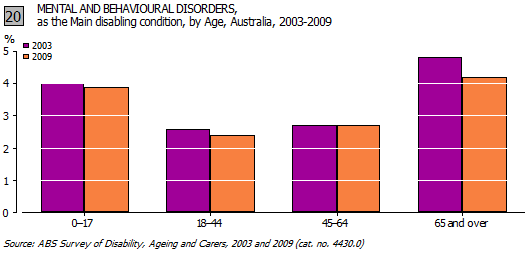
The greatest decrease in mental and behavioural disorders as the main disabling condition was in Western Australia, from 3.9% to 2.9%. Victoria, Queensland and South Australia also experienced decreases between 2003 and 2009. Prevalence rates in New South Wales and Tasmania increased by 0.5% and 0.4% respectively. The Australian Capital Territory experienced the greatest increase of 0.9% (Graph 21).
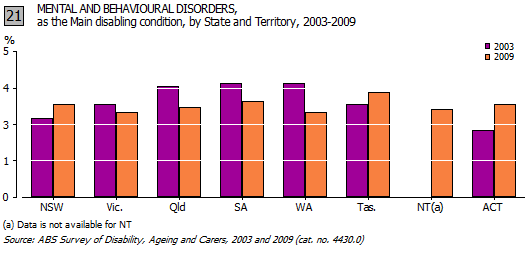 |
|
|
 Print Page
Print Page
 Print All
Print All